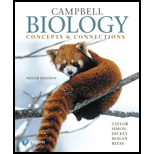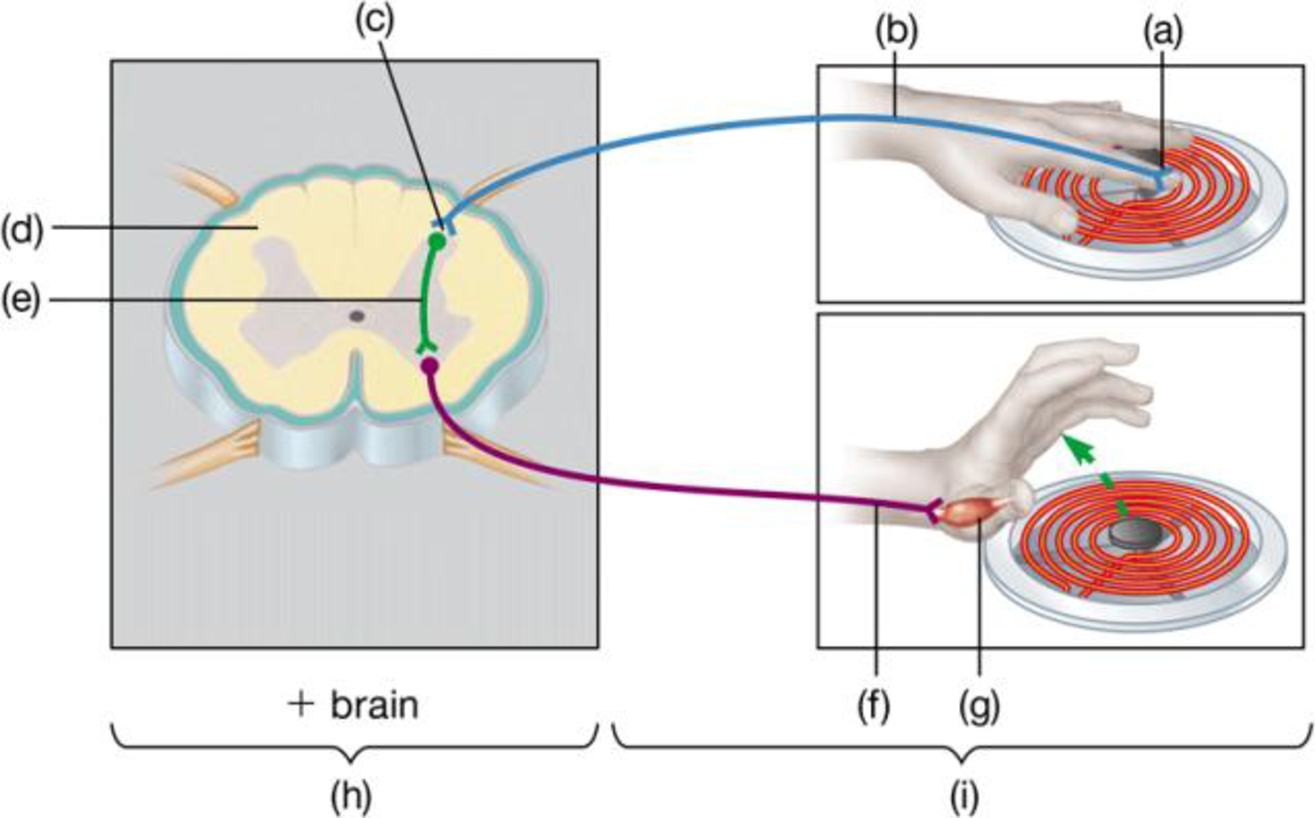
Test your understanding of the nervous system by matching the following labels with their corresponding letters: CNS, effector cells, interneuron, motor neuron, PNS, sensory neuron, sensory receptor, spinal cord, synapse.

To label: The system involved in reflex action and also to list the points that take part in conduction of nerve signals during the process.
Concept introduction: A collection of nerves, the brain, and the spinal cord that together help in regulation of signals from one part of the body to another is called the nervous system. The primary unit of the nervous system is a specialized cell that is termed as a neuron.
Answer to Problem 1CC
Pictorial representation: Fig.1 shows the systems involved in transmission of signal and response generated by the brain.

Fig.1: System involved in nerve conduction
Explanation of Solution
(a)
Correct answer: Sensory receptor.
Sensory receptors are present on dendrites to neurons that are specialized in receiving signals from the environment. The receptor that receives a signal from the external environment is termed as external sensory receptor, whereas the receptor that receives a stimulus from the internal environment is termed as an internal sensory receptor. Hence, the correct answer is a sensory receptor.
(b)
Correct answer: Sensory neuron.
Sensory neurons are the neurons that specialize in transferring the stimulus from the sensory receptor to the brain or spinal cord. The movement of stimulus through the sensory neurons is termed as sensory induction. Hence, the correct answer is a sensory neuron.
(c)
Correct answer: Synapse.
Synapse is the site where the signal passes to the next neuron or to the effector cell with the help of an electrical or a chemical signal (neurotransmitter). Hence, the correct answer is synapse.
(d)
Correct answer: Spinal cord.
The spinal cord is a part of the central nervous system. Transmission of a nerve signal from the sensory neuron to the brain for further processing is done with the help of the spinal cord and the neurons that are present in it. Hence, the correct answer is spinal cord.
(e)
Correct answer: Interneuron
Interneuron is a part of the central nervous system that helps in conveying the signals between sensory neuron and motor neuron. Interneuron is found in the spinal cord. Hence, the correct answer is an interneuron.
(f)
Correct answer: Motor neuron.
Motor neuron conducts the movement of signals from the brain and spinal cord to the cell where the response is needed. Cell body of a motor neuron is located in the spinal cord and the axon part of the cell is located toward muscle or gland where action is needed. Hence, the correct answer is a motor neuron.
(g)
Correct answer: Effector cell.
Effector cell is present in the glands and muscles. It receives the signal from the motor neuron and generates a physiological response in the body part. Hence, the correct answer is an effector cell.
(h)
Correct answer: Central nervous system.
The central nervous system (CNS) is responsible for actions that the body takes in response to an external stimulus. It receives the signal from the receptors, processes the reflex by the CNS, and transmits a signal to the effector cell. The central nervous system consists of two main parts: the spinal cord and the brain. Hence, the correct answer is the central nervous system.
(i)
Correct answer: Peripheral nervous system.
The peripheral nervous system consists of nerves and their neurons. It includes receptor cell, sensory neuron, interneuron, motor neuron, and effector cell. PNS connects the body to CNS. Hence, the correct answer is the peripheral nervous system.
Want to see more full solutions like this?
Chapter 28 Solutions
Campbell Biology: Concepts & Connections (9th Edition)
- Test Your Understanding 8. VISUALIZE Label the diagram of the human brain.arrow_forwardTest Your Understanding Know and Comprehend 1. Summing incoming neural signals is part of (a) reception (b) transmission (c) integration (d) action by effectors (e) afferent neuron transmissionarrow_forwardTaylor accidentally dips his fingers into a cup filled with steaming hot coffee. He immediately withdraws his hand and then exclaims “ouch!”What is the correct order of the nervous system structures involved in the scenario described above? Select one: a. sensory neuron, effector, motor neuron, interneuron b. motor neuron, receptor, sensory neuron, effector c. receptor, sensory neuron, interneuron, motor neuron d. sensory neuron, interneuron, effector, motor neuronarrow_forward
- How does the entire nervous system allow our bodies to interact with all of the world?(explain the path/ how the nervous system works.) your response must include the following terms: peripheral nervous system, central nervous system, sensory neurons, and motor neurons.arrow_forwardTest your Understanding Know and Comprehend 1. A sensory receptor absorbs energy from some stimulus. The next step is (a) release of neurotransmitter (b) transmission of an action potential (c) energy transduction (d) transmission of a receptor potential (e) sensory adaptationarrow_forwardVisit this site (http://openstaxcollege.org/l/nervetissue3) to learn about how nervous tissue is composed of neurons and glial cells. The neurons are dynamic cells with the ability to make a vast number of connections and to respond incredibly quickly to stimuli and to initiate movements based on those stimuli. They are the focus of intense research as failures in physiology can lead to devastating illnesses. Why are neurons only found in animals? Based on what this article says about neuron function, why wouldnt they be helpful for plants or microorganisms?arrow_forward
- Watch this video (http://openstaxcollege.org/l/neuroexam2) for an introduction to the neurological exam. Studying the neurological exam can give insight into how structure and function in the nervous system are interdependent. This is a tool both in the clinic and in the classroom, but for different reasons. In the clinic, this is a powerful but simple tool to assess a patient’s neurological function. In the classroom, it is a different way to think about the nervous system. Though medical technology provides noninvasive imaging and real-time functional data, the presenter says these cannot replace the history at the core of the medical examination. What does history mean in the context of medical practice?arrow_forwardVisit this site (http://openstaxcollege.org/l/troublewstairs) to read about a woman that notices that her daughter is having trouble walking up the stairs. This leads to the discovery of a hereditary condition that affects the brain and spinal cord. The electromyography and MRI tests indicated deficiencies in the spinal cord and cerebellum, both of which are responsible for controlling coordinated movements. To what functional division of the nervous system would these structures belong?arrow_forwardVisit this site (http://openstaxcollege.org/l/neurolab) to see a virtual neurophysiology lab, and to observe electrophysiological processes in the nervous system, where scientists directly measure the electrical signals produced by neurons. Often, the action potentials occur so rapidly that watching a screen to see them occur is not helpful. A speaker is powered by the signals recorded from a neuron and it pops each time the neuron fires an action potential. These action potentials are firing so fast that it sounds like static on the radio. Electrophysiologists can recognize the patterns within that static to understand what is happening. Why is the leech model used for measuring the electrical activity of neurons instead of using humans?arrow_forward
- Watch this video (http://openstaxcollege.org/l/lumbarpuncture) that describes the procedure known as the lumbar puncture, a medical procedure used to sample the CSF. Because of the anatomy of the CNS, it is a relative safe location to insert a needle. Why is the lumbar puncture performed in the lower lumbar area of the vertebral column?arrow_forwardThe nervous system has definitely homeostatic relationships with other body systems. Cite at least 5 examples of this homeostatic relationship/s (cite your reference)arrow_forwardWhat are the similarities and differences of autonomic and somatic nervous system in terms of function? Pls explain in sentences. And dont just copy paste from google thanks.arrow_forward
 Biology (MindTap Course List)BiologyISBN:9781337392938Author:Eldra Solomon, Charles Martin, Diana W. Martin, Linda R. BergPublisher:Cengage Learning
Biology (MindTap Course List)BiologyISBN:9781337392938Author:Eldra Solomon, Charles Martin, Diana W. Martin, Linda R. BergPublisher:Cengage Learning Anatomy & PhysiologyBiologyISBN:9781938168130Author:Kelly A. Young, James A. Wise, Peter DeSaix, Dean H. Kruse, Brandon Poe, Eddie Johnson, Jody E. Johnson, Oksana Korol, J. Gordon Betts, Mark WomblePublisher:OpenStax College
Anatomy & PhysiologyBiologyISBN:9781938168130Author:Kelly A. Young, James A. Wise, Peter DeSaix, Dean H. Kruse, Brandon Poe, Eddie Johnson, Jody E. Johnson, Oksana Korol, J. Gordon Betts, Mark WomblePublisher:OpenStax College Biology: The Dynamic Science (MindTap Course List)BiologyISBN:9781305389892Author:Peter J. Russell, Paul E. Hertz, Beverly McMillanPublisher:Cengage Learning
Biology: The Dynamic Science (MindTap Course List)BiologyISBN:9781305389892Author:Peter J. Russell, Paul E. Hertz, Beverly McMillanPublisher:Cengage Learning



